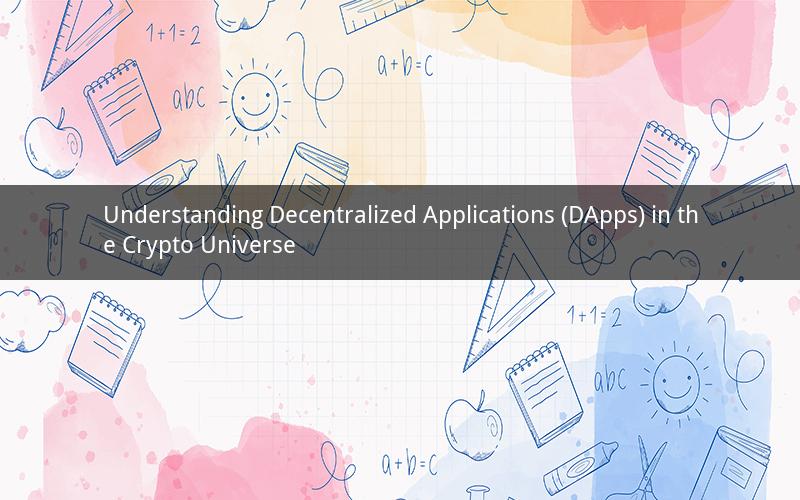
In the rapidly evolving world of cryptocurrencies, decentralized applications (DApps) have emerged as a revolutionary concept. These applications operate on blockchain technology, providing users with unparalleled security, transparency, and autonomy. In this article, we will delve into what DApps are, how they function, and their potential impact on various industries.
What are DApps?
DApps, or decentralized applications, are software programs that run on a blockchain network. Unlike traditional applications, which rely on a central authority, DApps operate on a decentralized network of computers, often referred to as nodes. This decentralization ensures that no single entity has control over the application, making it resistant to censorship and manipulation.
How do DApps work?
DApps are built on blockchain technology, which is a distributed ledger that records transactions across multiple computers. When a user interacts with a DApp, their actions are recorded on the blockchain, creating a transparent and immutable record of transactions. This process is secured by cryptographic algorithms, ensuring the integrity of the data.
DApps can be developed using various programming languages and frameworks, such as Solidity for Ethereum, which is one of the most popular platforms for DApps. These applications can range from simple games to complex financial systems, and they offer numerous benefits over traditional applications.
Benefits of DApps
1. Security: DApps operate on blockchain technology, which is inherently secure. The decentralized nature of blockchain makes it nearly impossible for hackers to tamper with the data or manipulate the application.
2. Transparency: Since DApps operate on a decentralized network, all transactions are visible to all users. This transparency ensures that there is no room for fraud or manipulation.
3. Autonomy: DApps eliminate the need for intermediaries, such as banks or governments, by allowing users to interact directly with each other. This gives users more control over their data and financial transactions.
4. Immutability: Once a transaction is recorded on the blockchain, it cannot be altered or deleted. This ensures that the data remains accurate and reliable.
5. Scalability: DApps can handle a large number of transactions simultaneously, making them suitable for applications with high user engagement.
Examples of DApps
1. Decentralized Finance (DeFi): DeFi platforms, such as Aave and Uniswap, offer decentralized lending, borrowing, and trading services without the need for traditional financial intermediaries.
2. Gaming: DApps like CryptoKitties and Decentraland have gained popularity in the gaming industry, allowing users to buy, sell, and trade digital assets.
3. Supply Chain Management: DApps can be used to track the movement of goods and services in real-time, ensuring transparency and efficiency in supply chain operations.
4. Voting Systems: DApps can be used to create secure and transparent voting systems, eliminating the possibility of tampering or fraud.
5. Identity Management: DApps can provide users with a secure and private digital identity, reducing the risk of identity theft and fraud.
Challenges and Future of DApps
While DApps offer numerous benefits, they also face several challenges, such as scalability, regulatory issues, and user adoption. However, as blockchain technology continues to evolve, these challenges are expected to be addressed, leading to a more widespread adoption of DApps.
1. Scalability: Blockchain networks can struggle to handle a large number of transactions simultaneously, leading to high transaction fees and slow processing times. However, advancements in blockchain technology, such as sharding and layer-2 solutions, are expected to address this issue.
2. Regulatory Issues: As DApps operate on a decentralized network, it can be difficult for governments to regulate them. This can lead to legal uncertainty and potential restrictions on DApps in certain regions.
3. User Adoption: DApps require users to have a certain level of technical knowledge and be willing to interact with blockchain technology. Increasing user adoption will depend on making the process more accessible and user-friendly.
In conclusion, DApps are a revolutionary concept that has the potential to disrupt various industries. As blockchain technology continues to evolve, we can expect to see more innovative DApps being developed, offering users unparalleled security, transparency, and autonomy.
Questions and Answers:
1. Q: What is the difference between a DApp and a traditional application?
A: A DApp operates on a decentralized network, providing users with unparalleled security, transparency, and autonomy, while a traditional application relies on a central authority and is subject to censorship and manipulation.
2. Q: How does DApp development differ from traditional application development?
A: DApp development requires knowledge of blockchain technology and programming languages like Solidity, while traditional application development involves using various programming languages and frameworks based on the application's requirements.
3. Q: Can DApps be used for everyday transactions?
A: Yes, DApps can be used for everyday transactions, such as shopping, banking, and gaming, by eliminating the need for intermediaries and providing users with more control over their data and financial transactions.
4. Q: What is the future of DApps in the crypto industry?
A: The future of DApps in the crypto industry is promising, as blockchain technology continues to evolve and address existing challenges. We can expect to see more innovative DApps being developed and a more widespread adoption of DApps across various industries.
5. Q: How can DApps improve the current financial system?
A: DApps can improve the current financial system by eliminating intermediaries, reducing transaction costs, and providing users with more control over their financial transactions. This can lead to a more transparent, secure, and efficient financial system.